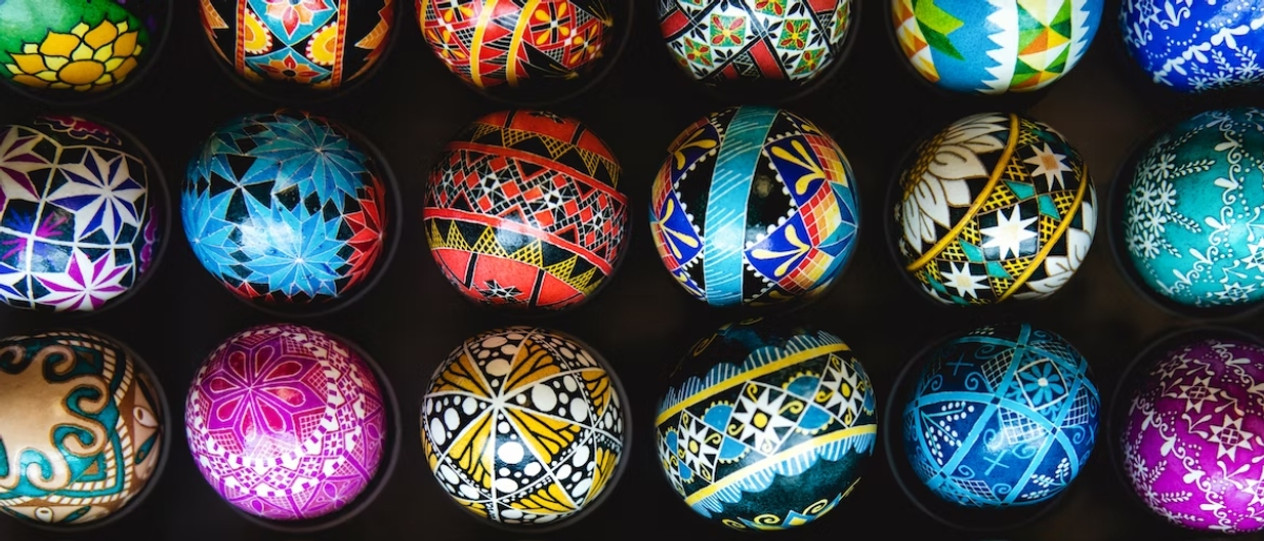The Meaning & Message of Pysanky - A Ukrainian Easter Tradition
Mar 08, 2023 by Cheryl Hadley
In the Christian Easter traditions of the East and West, as well as the secular celebration of Easter, eggs figure prominently. For Ukrainians, the custom of decorating Easter eggs (called pysanky) is not just a popular tradition, but a rich and historic art form handed down through the centuries.
What are Pysanky?
A pysanka (plural "pysanky") is a Ukrainian Easter Egg, decorated using an ancient process involving wax and special dyes. Pysanka comes from the Ukrainian word "pysaty," which means "to write." The designs are not painted on, but "written" onto the egg, using beeswax.
Traditional folk motifs and symbolic designs and colors characterize pysanky, which are often multi-colored and feature flowers, crosses, geometric lines, and other rich and meaningful symbols.
Striking aspects of Slavic art and culture are reflected in the pysanky. Archaeologists believe that they were produced in prehistoric Ukraine, but because eggshells are so fragile, only one ancient pysanka has been found and studied. Scientists have also found decorated ceramic eggs dating back to the 5th century that utilize similar colors, symbols, and patterns.

The Ukrainian Gift of Pysanky
Since ancient times, Ukrainians have made and given pysanky as special gifts. Children and godchildren received pysanky, and the unmarried maidens and eligible young men in the community exchanged the delicate treasures each spring.
People gave the intricate eggs to their priests as a sign of admiration and thanks. They left pysanky in the cemetery on the grave sites of beloved family members who had died.
Believing that the pysanky brought good fortune, Ukrainians left the eggs in their mangers and hen houses, and placed them beneath their beehives or in their fields, hoping to ensure a good harvest and a generous production of milk, honey, and other staples needed for daily life.
[[50959,12405]]
Enduring Cultural Roots
The art of pysanky is a pre-Christian cultural practice. Like many such practices, folklore and superstition intertwined with a beloved custom. Long before Christianity came to the Ukraine in 988, Ukrainians in pagan times heralded the coming of spring with their intricately decorated and colorful pysanky.
Later, followers of Christ incorporated Christian symbols and colors that represented their deep faith. This retained the ancient tradition of their Slavic culture, expanding it to include a richer and more meaningful interpretation. New faith blended with old customs to incorporate Christian meaning and teachings into pysanky.
The eggs were enjoyed until Joseph Stalin, dictator of the Soviet Union, banned them in an effort to eliminate all religion. While we openly and joyfully dye Easter eggs in modern times, often with children, the Ukrainian people made pysanky in the dark of night when their children slept.
They decorated the eggs while hiding in their closets by candlelight, risking their lives to preserve and celebrate this ancient tradition that now incorporated their Christian faith.

How are Pysanky Made?
Using a clean, dry, raw egg, the decorator draws a design in pencil. With a special stylus called a kistka he traces the penciled pattern in liquid wax. The wax seals off the written designs so they remain free of dye once the egg is immersed.
Wax is continually added between dying so that the design becomes more detailed and complex. More layers and colors are incorporated as the egg is immersed in different dyes. Once all the desired colors and layers are complete, the artist places the egg near a candle and melts away the wax.
[[50958]]
This reveals the intricate patterns and beautiful colors, written over in layers beneath the waxed design. The eggs are dried and sealed with a special varnish. Pysanky are raw eggs, so before or after the design is completed, the white and yolk can be drained from a hole in the bottom, or allowed to dry up inside the egg over time.
Either way, pysanky are incredibly fragile, so the precious gifts must be handled with great care.

Common Symbols & Colors
Both Christian patterns and designs taken from ancient Slavic folklore and culture are used to create pysanky. Flowers symbolize charity. Vines, branches, leaves, grapes, and wheat reference prosperity. Stars represent love.
A Crown of Thorns or Cross symbolizes Christ's Passion. Dots are the tears of Our Lady. Triangles illustrate the Holy Trinity. Netting or overlapping grids speak of the Gospels and Apostles as "fishers of men." Repeated geometric waves, and lines encircling a pysanka represent eternal life.
The eggs are a beautiful expression of love and devotion, and colors and patterns are chosen to reflect the personality and style of the designer or recipient.
[[50960, 50956]]
White symbolizes purity, light, and birth. Yellow stands for warmth, youth, happiness, the sun, and Christ the Son. Orange characterizes strength and endurance. Red depicts resurrection and sacrifice, and reflects hope, passion, and love. Green illustrates the season of spring, restoration, and renewal. Brown is a reminder of the earth, and black is the color of eternity and respect for the dead.

Partaking in an Easter Tradition
Churches around the world offer workshops to teach the art of pysanky. We have many versions of pysanky available at The Catholic Company—browse the items in this article to see!
The pysanky tradition is a beautiful way to share in the heritage of the Eastern Church and bring the light and joy of the Resurrection into your home at Eastertime.
[[50957, 48489]]





